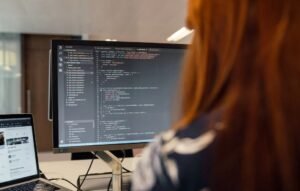Supervised Learning Mathematical Definition
Supervised learning is a subfield of machine learning, where an algorithm learns from labeled training data to make predictions or decisions. It involves a mathematical framework that allows the algorithm to learn from data samples containing input features and their corresponding target labels.
Key Takeaways
- Supervised learning is a subfield of machine learning.
- It relies on labeled training data to make predictions.
- Training data consists of input features and target labels.
- Supervised learning algorithms build models based on the training data.
In supervised learning, the algorithm receives a set of input features along with their corresponding target labels. The algorithm’s task is to learn a mapping function that can predict the target labels for new, unseen input features. This mapping function is typically represented as a mathematical model, such as a regression equation or a decision tree.
For example, in a supervised learning scenario where the input features represent certain characteristics of a house (e.g., area, number of bedrooms), and the target labels represent the house’s price, the algorithm learns to predict the price based on the input features. It uses the training data, which consists of known characteristics and prices of multiple houses, to build the mathematical model for making future price predictions.
*Supervised learning algorithms learn a mapping function to predict target labels based on input features.*
Supervised Learning Process
The process of supervised learning typically involves the following steps:
- Acquiring labeled training data: Training data must be collected or obtained, containing a set of input features and their corresponding target labels. This data is used to train the algorithm.
- Choosing an appropriate algorithm: Based on the problem and the characteristics of the dataset, a suitable supervised learning algorithm is selected. There are various algorithms available, such as linear regression, logistic regression, support vector machines, and decision trees.
- Model training: The selected algorithm is used to train a mathematical model using the labeled training data. The algorithm learns the relationships between the input features and the target labels.
- Evaluating the model: Once the model is trained, it is evaluated using a separate set of data called the test data. This evaluation measures the accuracy or performance of the model in predicting the target labels for unseen input features.
- Model deployment: If the model performs well, it can be deployed in real-world applications to make predictions or decisions.
*Choosing the right algorithm and evaluating the model are crucial steps in the supervised learning process.*
Supervised vs. Unsupervised Learning
In contrast to supervised learning, unsupervised learning deals with unlabeled data. It aims to discover hidden patterns, relationships, or structures within the dataset without any predefined target labels. Unsupervised learning algorithms use techniques such as clustering or dimensionality reduction to identify similarities or groupings in the data.
For example, in a customer segmentation task, an unsupervised learning algorithm may group customers based on their purchasing patterns, without any prior knowledge of defined customer segments. This allows businesses to gain insights into different customer groups and tailor their marketing strategies accordingly.
*Unlike supervised learning, unsupervised learning analyzes data without relying on predefined target labels.*
Supervised Learning Algorithms
There are various supervised learning algorithms available, each suited for different types of problems and datasets. Here are three commonly used supervised learning algorithms:
1. Linear Regression:
Linear regression is a simple and widely used algorithm for predicting continuous target variables. It assumes a linear relationship between the input features and the target labels and estimates the best-fit line that minimizes the sum of squared errors. The resulting equation can be used to predict the target labels for new inputs.
2. Decision Trees:
Decision trees are versatile algorithms that can handle both classification and regression problems. They build a hierarchical structure of decision nodes based on the input features to make predictions. Decision trees are known for their interpretability and ability to handle non-linear relationships in the data.
3. Support Vector Machines (SVM):
SVM is a powerful algorithm for classification tasks. It finds an optimal hyperplane in a high-dimensional space to separate different classes in the data. SVM can handle complex decision boundaries and is effective even in cases where the data is not linearly separable.
*Linear regression, decision trees, and SVM are popular supervised learning algorithms with different applications.*
Data Points and Performance Measures
| Measure | Description |
|---|---|
| Accuracy | The overall correctness in predicting the target labels. It is the ratio of correctly predicted labels to the total number of instances. |
| Precision | The proportion of correctly predicted positive labels (true positives) among all predicted positive labels (true positives and false positives). |
| Recall | The proportion of correctly predicted positive labels (true positives) among all actual positive labels (true positives and false negatives). |
In supervised learning, there are various data points and performance measures that can provide insights into the effectiveness of the algorithm. These include:
- Confusion matrix: A matrix that summarizes the performance of a classification algorithm by showing the counts of true positives, true negatives, false positives, and false negatives.
- Receiver Operating Characteristic (ROC) curve: A curve that represents the trade-off between the true positive rate and the false positive rate for different threshold values in a binary classification problem.
- Area Under the ROC Curve (AUC-ROC): A measure of how well a classification model can distinguish between classes. It ranges from 0.0 to 1.0, with higher values indicating better performance.
*Performance measures such as accuracy, precision, and recall provide insights into the algorithm’s effectiveness.*
Key Takeaways
- Supervised learning has a mathematical framework for learning from labeled training data.
- Algorithmic models are built based on the training data to make predictions or decisions.
- Supervised learning involves choosing the right algorithm, evaluating the model, and deploying it in real-world applications.
- Unsupervised learning contrasts with supervised learning, with no reliance on predefined target labels.
- Linear regression, decision trees, and SVM are popular supervised learning algorithms.
- Performance measures such as accuracy, precision, and recall provide insights into the algorithm’s effectiveness.

Common Misconceptions
Misconception 1: Supervised learning is all about mathematical equations
One common misconception people have about supervised learning is that it revolves solely around mathematical equations. While mathematics plays a crucial role in the algorithms and models used in supervised learning, it is not the only factor at play. Supervised learning is a broader concept that involves the use of labeled data to train models and make predictions.
- Supervised learning involves data labeling and classification
- Mathematics is used to optimize models and algorithms in supervised learning
- Understanding the mathematical foundations can enhance the understanding of supervised learning
Misconception 2: Perfect prediction is achievable in supervised learning
Another misconception is that supervised learning can always achieve perfect predictions. In reality, perfect prediction is often unattainable and depends on various factors, such as the quality of the labeled data, model complexity, and inherent variability in the data. While supervised learning aims to minimize prediction errors, it is important to recognize that some level of uncertainty is inherent in any prediction task.
- Supervised learning models always have some degree of error
- Prediction accuracy is influenced by data quality and model complexity
- Understanding prediction uncertainty is crucial in supervised learning
Misconception 3: Supervised learning is limited to numerical data
Many people wrongly assume that supervised learning is restricted to dealing only with numerical data. However, supervised learning can handle various types of data, including categorical, ordinal, and even text data. Different types of models and techniques are employed to deal with different data structures, allowing supervised learning to be applied to a wide range of problems.
- Supervised learning can handle categorical and ordinal data through encoding
- Text data can be processed and transformed for supervised learning tasks
- Understanding the data type is crucial in choosing appropriate models for supervised learning
Misconception 4: Supervised learning doesn’t require feature engineering
There is a misconception that supervised learning does not require any feature engineering. Feature engineering involves selecting, transforming, and creating features from the raw data to improve model performance. In reality, feature engineering is a vital step in supervised learning as it helps to extract relevant information and reduce noise, leading to more accurate predictions.
- Feature engineering can improve the performance and interpretability of models
- Feature selection and transformation are key aspects of supervised learning
- Domain knowledge helps in identifying informative features for supervised learning
Misconception 5: Supervised learning is a one-time process
Some people mistakenly believe that supervised learning is a one-time process, where you train a model once and expect it to make accurate predictions forever. However, models in supervised learning require periodic updates and retraining to account for changing data patterns and to maintain their predictive power. Keeping up-to-date with new data and retraining models is essential in ensuring reliable and accurate performance.
- Supervised learning models need to be updated and retrained periodically
- New data can influence the predictions of a supervised learning model
- Regular evaluation of model performance is necessary in supervised learning

Introduction
In this article, we will explore the mathematical definition of supervised learning. Supervised learning is a machine learning technique where a model learns from labeled training data to make predictions or decisions. It involves finding a function that maps input variables to their corresponding output variables based on known examples.
Table: 1 – Supervised Learning Algorithms
Supervised learning algorithms are used to train models in various domains. Here are a few examples:
| Algorithms | Application |
|---|---|
| Linear Regression | Predicting house prices |
| Decision Trees | Classifying customer segments |
| Support Vector Machines | Recognizing handwriting |
| Random Forests | Detecting fraud |
Table: 2 – Supervised Learning Components
A supervised learning problem involves the following components:
| Components | Description |
|---|---|
| Input Variables | The features or independent variables used for prediction |
| Output Variables | The target variable to be predicted |
| Training Data | Labeled examples used for model training |
| Model | The algorithm used to learn the mapping function |
Table: 3 – Evaluation Metrics
When assessing the performance of a supervised learning model, different evaluation metrics are used:
| Metric | Description |
|---|---|
| Accuracy | The proportion of correctly predicted instances |
| Precision | The proportion of true positive predictions |
| Recall | The proportion of actual positives correctly predicted |
| F1 Score | The weighted average of precision and recall |
Table: 4 – Bias-Variance Tradeoff
In supervised learning, the bias-variance tradeoff is an important concept to consider:
| Tradeoff | Description |
|---|---|
| Bias | The error due to overly simplified assumptions |
| Variance | The error due to excessive complexity |
Table: 5 – Feature Extraction Techniques
Feature extraction plays a vital role in improving the performance of supervised learning models:
| Technique | Description |
|---|---|
| Principal Component Analysis (PCA) | Reduces the dimensionality of the data |
| Feature Scaling | Normalizes feature values to a specific range |
| Feature Selection | Selects relevant features based on importance |
Table: 6 – Support Vector Machines (SVM) Parameters
Support Vector Machines have various parameters that affect their performance:
| Parameter | Description |
|---|---|
| Kernel Type | The type of kernel function used |
| C | Regularization parameter |
| Gamma | Kernel coefficient |
Table: 7 – Example: Linear Regression
Linear regression is a simple yet powerful supervised learning algorithm:
| Input (x) | Output (y) |
|---|---|
| 2 | 5 |
| 4 | 8 |
| 7 | 11 |
| 9 | 15 |
Table: 8 – Example: Decision Tree
Decision trees can be used for classification and regression tasks:
| Features | Target |
|---|---|
| Sepal Length | Setosa |
| Sepal Width | Versicolor |
| Petal Length | Virginica |
| Petal Width | Versicolor |
Table: 9 – Example: Support Vector Machines
Support Vector Machines have been applied to various domains successfully:
| Features | Label |
|---|---|
| Age | High Income |
| Education Level | Low Income |
| Marital Status | High Income |
| Occupation | Low Income |
Table: 10 – Example: Random Forest
Random forests are ensembles of decision trees:
| Features | Label |
|---|---|
| Temperature | Rainy |
| Humidity | Sunny |
| Wind Speed | Cloudy |
| Pressure | Rainy |
Conclusion
Supervised learning is a fundamental concept in machine learning. Through the use of various algorithms such as Linear Regression, Decision Trees, Support Vector Machines, and Random Forests, we can extract insights and make predictions from labeled training data. The evaluation of the models’ performance using metrics like accuracy, precision, recall, and F1 Score helps us gauge their efficacy. Additionally, feature extraction techniques, understanding the bias-variance tradeoff, and fine-tuning algorithm parameters play essential roles in obtaining the most accurate predictions. By applying supervised learning techniques effectively, we can solve complex problems across a wide range of domains.
Frequently Asked Questions
What is supervised learning?
The mathematical definition of supervised learning refers to a type of machine learning process in which an algorithm learns from examples provided by a labeled dataset. The algorithm is trained on input data and their corresponding output labels and is designed to make accurate predictions or decisions on new, unseen data.
What is the mathematical definition of supervised learning?
The mathematical definition of supervised learning involves the use of statistical learning techniques to develop a model that can predict labels or outcomes for unseen data based on a labeled training dataset. It typically involves minimizing a predefined objective function, such as maximizing the likelihood of correct predictions.
How does supervised learning work?
In supervised learning, the algorithm learns patterns or relationships in the training data and creates a model that maps input features to corresponding output labels. This model is then used to predict labels for new data points. The learning process is guided by a predefined set of labeled examples, which the algorithm uses to adjust its parameters until it can make accurate predictions on unseen data.
What are the key components of supervised learning?
The key components of supervised learning include a labeled training dataset, a learning algorithm, a model, and a prediction task. The training dataset consists of input features and their corresponding output labels. The learning algorithm processes this dataset to create a model that can make accurate predictions on new data. The prediction task involves using the trained model to predict output labels.
What are some popular algorithms used in supervised learning?
There are several popular algorithms used in supervised learning, including linear regression, logistic regression, decision trees, support vector machines (SVM), naive Bayes, k-nearest neighbors (KNN), and neural networks. Each algorithm has its own strengths and limitations, making them suitable for different types of problems.
What is the role of training and testing data in supervised learning?
In supervised learning, the training data is used to train the algorithm and create a model. The algorithm learns from the patterns and relationships in this labeled data to make accurate predictions. The testing data, on the other hand, is a separate set of data that is not used during training. It is used to evaluate the performance of the trained model on unseen data and assess its generalization ability.
How is supervised learning different from unsupervised learning?
Supervised learning and unsupervised learning are two main types of machine learning. The main difference lies in the presence or absence of labeled data. In supervised learning, the algorithm learns from labeled examples to make predictions, while in unsupervised learning, the algorithm learns patterns and structures in unlabeled data without any predefined output labels.
What are the advantages of supervised learning?
Supervised learning offers several advantages, including the ability to make accurate predictions on unseen data, the capability to handle complex data patterns, and the potential for automation and decision-making in various domains. It is widely used in applications such as spam detection, image recognition, sentiment analysis, and medical diagnosis.
What are the limitations of supervised learning?
Supervised learning has its limitations, including the reliance on labeled data, the need for representative and diverse training datasets, and potential overfitting if the model becomes too complex. It is also prone to errors if the training data is noisy or biased, and it may face challenges with high-dimensional data or unbalanced class distributions.
How do I choose the right algorithm for my supervised learning problem?
Choosing the right algorithm for a supervised learning problem depends on various factors such as the nature of the data, the problem type (classification or regression), the size of the dataset, and the available computational resources. It is recommended to consider the strengths and weaknesses of different algorithms and perform experiments or consult experts to determine the most suitable algorithm for the specific problem at hand.




